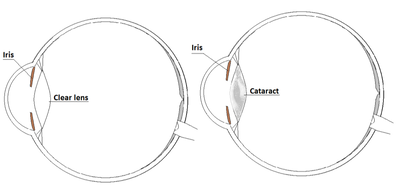Cataracts

A cataract is a clouding of all or part of the crystalline lens within your eye. The crystalline lens is a normally clear lens, which sits behind the colored part of your eye (the iris) and is responsible for focusing.
A chemical change occurs within your eye to cause the lens to become cloudy. Cataracts are most often found in persons over age 50, but they are also occasionally found in younger people. They can also be heredity or the result of an injury or disease. Risk factors include: excessive exposure to ultraviolet radiation in sunlight, cigarette smoking, or the use of certain medications. Although cataracts develop without pain or discomfort, there are some indications that a cataract may be forming.
Symptoms include:
- Blurred or hazy vision,
- The appearance of spots in your vision,
- Increased sensitivity to glare, or
- The feeling of having a film over the eyes.
- A temporary improvement in near vision may also indicate formation of a cataract.
Currently, there is no proven method to prevent cataracts from forming. During a comprehensive eye examination, we can diagnose a cataract and monitor its development and prescribe changes in eyeglasses or contact lenses to maintain good vision.
If your cataract develops to the point that it affects your daily activities, we can refer you to an eye surgeon who may recommend surgery. During the surgery, the eye's natural lens is removed and usually replaced with an artificial lens. After surgery, you can return to our office for continuing care.

